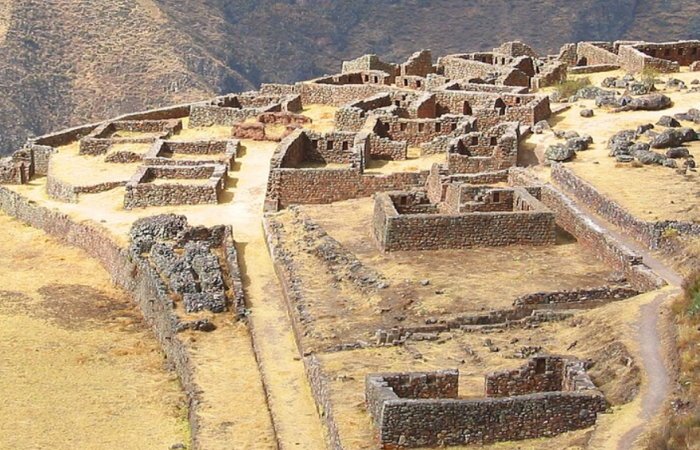Beautiful Ancient City Of Pisac In The Sacred Valley, Peru – Incredible Inca Ruins
Ellen Lloyd - AncientPages.com - Ancient city of Pisac in the Sacred Valley, Peru is not as famous as Machu Picchu, but it’s a remarkable place that is not only beautiful but also rich in history and legend.
Structures in the urban sector of the Inca complex at Pisac. Image credit: Leon Petrosyan - CC BY-SA 3.0
Known for its Incan ruins, the city of Pisac, located about 19 miles northeast of Cusco lies atop a hill at the entrance to the valley. The view is fantastic, and it seems that no matter where you stand, you can admire remarkable agriculture terraces that are still in use today.
It is said that in ancient times, the city was guarded at night by pumas.
Why Did Inca Build The City Of Pisac?
Why Pisac was built is not entirely clear. According to the scholar Kim MacQuarrie, Pachacuti erected a number of royal estates to memorialize victories over other ethnic groups. Among these royal estates are Písac (victory over the Cuyos), Ollantaytambo (victory over the Tambos), and Machu Picchu (conquest of the Vilcabamba Valley).
However, there are also historians who suggest Písac was established to protect Cusco from possible attacks from the outside.
The ruins are separated along the ridge into four groups known as P'isaqa, Inti Watana, Qalla Q'asa, and Kinchiraqay. In Quechua, Pisac means “partridge”. Inca tradition dictated building cities in the shape of birds and animals, and as such, Pisac is partridge shaped.
Partridge-shaped structures are related to the spirituality and values that the Incas believed that each human being should develop.
The Pisaq'a residential area in the Inca complex. Image credit: Bcasterline - Public Domain
There are twenty lookout towers of different sizes placed strategically throughout the ruins. Some are massive watchtowers that are placed so that messages could be shouted from one to the other, and there are other towers that were used to store water for the elaborate irrigation system.
The ruins in Pisac contain a group of thirty independent but uniform enclosures, which were probably used as apartments.
Legend Of Princess Inquill (Inkill) Chumpi And The Stone Figure
There are several ancient legends about this beautiful place in the Andean Mountains. One legend tells that a princess called Inkill Chumpi (princess of the Florida belt) owned the entire city. She would marry someone who could build a bridge over the Wilkamayu River (Vilcanota) in a single day.
After learning about this, many young men tried to accomplish what seemed like an impossible task. Asto Rimac, who was a secret lover of the princess owned the lands to the east. When Asto Rimac was started building the bridge, Princess Inkill Chumpi went to invoke the Apus (mountain spirits) to help him.
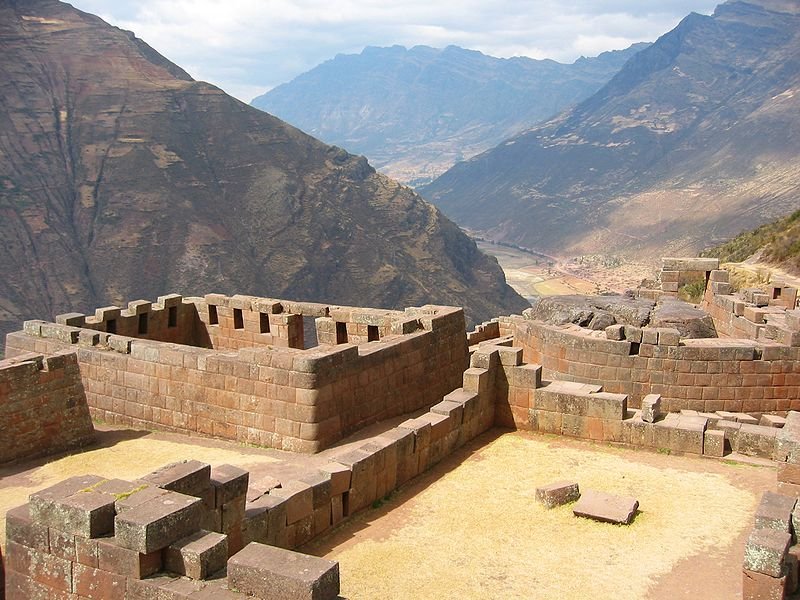 View of the Sacred Valley, Peru, from the Sun Temple (foreground) at Písac. Image credit: Bcasterline - Public Domain
View of the Sacred Valley, Peru, from the Sun Temple (foreground) at Písac. Image credit: Bcasterline - Public Domain
The spirits agreed to help him, but only if she didn’t look at the bridge until it was ready. Just before the bridge was finished, the princess began to hear loud thunders and gave in to the temptation to see what happened and turn to observe; At that moment, the Urubamba river swallowed Asto Rimac, and she was turned to stone, standing, looking towards the valley of Pisac. In the place until today can be seen as the figure of stone.
It is unknown when Inca Písac was built. There are no traces suggesting that Písac was inhabited by any pre-Inca civilization, so it was most likely built no earlier than 1440.
Francisco Pizarro and the Spanish conquerors destroyed Inca Písac in the early 1530s. The modern town of Písac was built in the valley by Viceroy Toledo during the 1570s.
Written by Ellen Lloyd – AncientPages.com
Updated on Oct 14, 2024
Copyright © AncientPages.com All rights reserved. This material may not be published, broadcast, rewritten or redistributed in whole or part without the express written permission of AncientPages.com
Expand for referencesMore From Ancient Pages
-
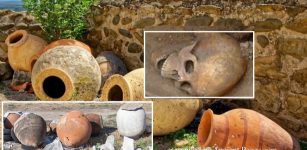 Researchers Develop New Ways Of Visualizing Ancient Small Objects By Combining Technologies
Archaeology | Apr 20, 2022
Researchers Develop New Ways Of Visualizing Ancient Small Objects By Combining Technologies
Archaeology | Apr 20, 2022 -
 Holmgang – Dangerous Viking Duel Settled Disputes
Ancient History Facts | Mar 10, 2018
Holmgang – Dangerous Viking Duel Settled Disputes
Ancient History Facts | Mar 10, 2018 -
 Spells, Charms, Erotic Dolls: Love Magic In The Ancient Mediterranean
Featured Stories | Oct 24, 2022
Spells, Charms, Erotic Dolls: Love Magic In The Ancient Mediterranean
Featured Stories | Oct 24, 2022 -
 Largest Ever Human Family Tree: 27 Million Ancestors Mapped
Archaeology | Feb 25, 2022
Largest Ever Human Family Tree: 27 Million Ancestors Mapped
Archaeology | Feb 25, 2022 -
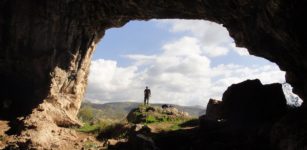 Startling Discovery Of Nubian Levallois Technology In Shukbah Cave Re-Writes Ancient History Of Neanderthals And Homo Sapiens
Archaeology | Feb 24, 2021
Startling Discovery Of Nubian Levallois Technology In Shukbah Cave Re-Writes Ancient History Of Neanderthals And Homo Sapiens
Archaeology | Feb 24, 2021 -
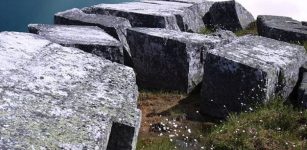 Mysterious Megaliths Of Russia May Offer Evidence Of An Ancient Advanced Lost Civilization
Ancient Technology | Jul 22, 2017
Mysterious Megaliths Of Russia May Offer Evidence Of An Ancient Advanced Lost Civilization
Ancient Technology | Jul 22, 2017 -
 Codebreakers Crack Secrets Of The Lost Letters Of Mary, Queen Of Scots
News | Feb 8, 2023
Codebreakers Crack Secrets Of The Lost Letters Of Mary, Queen Of Scots
News | Feb 8, 2023 -
 11,000-Year-Old Human Remains Found At Heaning Wood Bone Cave In Britain
Archaeology | Jan 25, 2023
11,000-Year-Old Human Remains Found At Heaning Wood Bone Cave In Britain
Archaeology | Jan 25, 2023 -
 Three Punic Wars Between Rome And Carthage Lasted Almost A Hundred Years
Featured Stories | Apr 29, 2019
Three Punic Wars Between Rome And Carthage Lasted Almost A Hundred Years
Featured Stories | Apr 29, 2019 -
 Return Of Pahana – The Lost White Brother Of The Hopi And The Sacred Tablet
Myths & Legends | Mar 5, 2018
Return Of Pahana – The Lost White Brother Of The Hopi And The Sacred Tablet
Myths & Legends | Mar 5, 2018 -
 Adventurous Viking Woman Who Challenged Social Norms And Whose Fate Was Foretold By A Völva
Featured Stories | Nov 5, 2025
Adventurous Viking Woman Who Challenged Social Norms And Whose Fate Was Foretold By A Völva
Featured Stories | Nov 5, 2025 -
 Ancient Mystery Of Egypt’s Black Pyramid – Did It Really Exist?
Ancient Mysteries | Nov 28, 2020
Ancient Mystery Of Egypt’s Black Pyramid – Did It Really Exist?
Ancient Mysteries | Nov 28, 2020 -
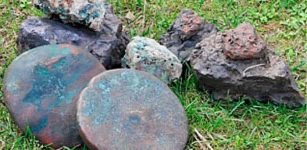 Ancient Disc-Shaped Copper Ingots Found In Shipwreck At Bulgaria’s Sea Coast
Archaeology | Apr 28, 2020
Ancient Disc-Shaped Copper Ingots Found In Shipwreck At Bulgaria’s Sea Coast
Archaeology | Apr 28, 2020 -
 Napta Playa – Egypt’s Stonehenge And Its Ancient Astronomical Alignments
Featured Stories | Feb 18, 2018
Napta Playa – Egypt’s Stonehenge And Its Ancient Astronomical Alignments
Featured Stories | Feb 18, 2018 -
 Burials Of An Unknown Race Of Unusually Small Humanoids Found In Ohio May Confirm Native American Legend
Featured Stories | Aug 18, 2024
Burials Of An Unknown Race Of Unusually Small Humanoids Found In Ohio May Confirm Native American Legend
Featured Stories | Aug 18, 2024 -
 Fossilized Remains Of Homo Erectus Found On Submerged Sundaland, Java Reveal More Secrets
Archaeology | May 21, 2025
Fossilized Remains Of Homo Erectus Found On Submerged Sundaland, Java Reveal More Secrets
Archaeology | May 21, 2025 -
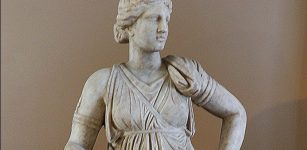 Goddess Artemis – One Of The Most Respected Olympians
Featured Stories | Oct 1, 2016
Goddess Artemis – One Of The Most Respected Olympians
Featured Stories | Oct 1, 2016 -
 King Solomon Was Invented As Political Propaganda To Unite People Of Judah – Scholars Argue
Biblical Mysteries | Feb 3, 2020
King Solomon Was Invented As Political Propaganda To Unite People Of Judah – Scholars Argue
Biblical Mysteries | Feb 3, 2020 -
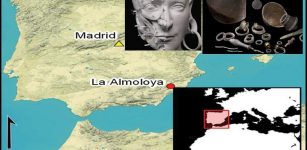 Disappearance Of The El Argar Civilization – Why Has No One Lived In The La Almoloya Region Again?
Civilizations | May 10, 2022
Disappearance Of The El Argar Civilization – Why Has No One Lived In The La Almoloya Region Again?
Civilizations | May 10, 2022 -
 Ancient Marble Statue Of Sphinx Discovered In Tang Dynasty Tomb
Archaeology | Dec 16, 2015
Ancient Marble Statue Of Sphinx Discovered In Tang Dynasty Tomb
Archaeology | Dec 16, 2015


